Report of The PDE : Little Red Classrooms
Source: Parents Defending Education 07-26-2023

INVESTIGATIONS
DISTRICTS: 143 (active & inactive), including 20 near military bases
FUNDING (2009-2023): $17,967,565.12
STATES: 34 and the District of Columbia
PART 1: OVERVIEW
WHAT ARE CONFUCIUS INSTITUTES AND CONFUCIUS CLASSROOMS?
According to a National Association of Scholars report, Confucius Institutes, and its K-12 programming called Confucius Classrooms, are “centers that teach Chinese language and culture.” Confucius programming creates a partnership between K-12 schools, universities or nonprofits, and a Chinese government entity.
Parents Defending Education uncovered contracts that show Confucius Classrooms, or other Chinese government backed programing, are still in operation at the following schools:
Cloverport Independent School District, KY
Minnetonka Public Schools, MN
St. Cloud Area School District, MN
Tulsa Public Schools, OK
Sisters School District, OR
Highland Park Independent School District, TX
Seattle Public Schools, WA
TOP LINES
1. Three of the nation’s top science and technology high schools have ties to Chinese government affiliated programs:
-Thomas Jefferson High School for Science and Technology has had ties to Tsinghua University High School—the high school affiliated with one of China’s top military schools, Tsinghua University.
-Simpson County Public Schools in Kentucky entered into an agreement with North China Electric Power University to operate Western Kentucky University’s Confucius Institute.
-North Carolina School of Science and Mathematics received a “Confucius Classroom of the Year” award from Hanban in 2018.
2. The CCP has had ties to school districts near 20 U.S. military bases.
3. While the United States is not officially part of China’s Belt and Road Initiative, Chinese state media has touted the work done by Confucius Institutes and Confucius Classrooms to further the Chinese Communist Party’s global influence.
In March, Parents Defending Education uncovered that a nonprofit linked to Thomas Jefferson High School for Science and Technology had received more than $1 million in financial aid from Chinese government-affiliated entities over the course of a decade.1
Further research reveals the People’s Republic of China fostered relationships with American K-12 schools through grants, sister school partnerships, and other programming since at least 2009. Parents Defending Education tracked affiliations in 143 schools across 34 states and Washington, D.C.—and at least seven are still active. Financial exchanges between K-12 schools and the Chinese government range from a few thousand dollars to, in Thomas Jefferson High School’s case, more than a million dollars. Disturbingly, the Chinese government’s ties appear to target school districts near 20 American military bases.

The list of Military Installations near Confucius Classrooms includes these well-known bases.
Programming and funding vary by school district. Carver Middle School, in Tulsa Public Schools, became a “Confucius School” through Hanban—the subdivision of the Chinese Ministry of Education that, until 2021, operated Confucius Institutes and Classrooms. Sisters School District in Oregon has an active contract with the Confucius Institute at Portland University.2 The district’s high school World Languages page noted that its Chinese program featured “three native speaker Chinese teachers sponsored by Hanban, a part of the China Ministry of Education.” In Texas, the Confucius Institute at the University of Texas at Dallas in 2020 gave Highland Park Independent School District a $20,000 grant for the “operation and supplies of the Chinese courses.” The funds were also to be used by a district staff member to “travel to China for educational purposes.”
The Chinese government’s effort to forge ties with American schools through its Ministry of Education is one facet of the Chinese Communist Party’s broader soft-power strategy to influence policy in nations throughout the world. Expanding Confucius Classrooms in the United States has been a top priority for the Chinese government, the United States Senate Permanent Subcommittee on Investigations found.3
The State Department designated Confucius Institutes a “foreign mission” of the Chinese Communist Party in 2020.4 As noted in the State Department’s report, these programs are funded in part by the Chinese government under guidance from the Chinese Communist Party’s United Front Work Department, “the Chinese Communist Party’s overseas propaganda and influence operation.”
As of March 2023, 13 Confucius Institutes are still in operation, and 108 have or are in the process of closing, according to the National Association of Scholars.
Confucius Institutes have garnered their share of controversy. Hanban’s former director Xu Lin demanded her staff remove references to Taiwanese institutions from a conference program, as well as withholding funding for not following the Chinese Communist Party line. Former Chinese Communist Party Senior Chairman Li Changchun in 2009 said that Confucius Institutes were “an important part of China’s overseas propaganda set-up.”5
The United States is not officially part of China’s Belt and Road Initiative—a global investment campaign launched in 2013 that seeks to advance the Chinese Communist Party’s policy infrastructure, technology, and education initiatives.6 However, Confucius Institutes, Confucius Classrooms, and other Chinese government-backed programming in the United States support Belt and Road Initiative efforts. A 2017 Hanban report stated that the “Confucius Institutes have become a vital force for international cooperation under the [sic] ‘Belt and Road’ initiative.” In a Chinese state media article from 2016, the Chinese Communist Party “lauded” Confucius Institutes and Confucius Classrooms for promoting its Belt and Road Initiative.
According to the Brookings Institution, in 2020 China’s Ministry of Education replaced Hanban with the Center for Language Education and Cooperation. The Chinese International Education Foundation, a “nominally independent” organization that is “supervised” by the Ministry of Education, now manages Confucius Institutes abroad.7
U.S.-based organizations, namely the College Board and Asia Society, worked with Hanban to tailor Chinese culture and language immersion programs to U.S. school districts. They also collaborated on funding Confucius programs in universities and K-12 schools. At times, these organizations would pair American universities with sister universities in China, which curbed costs for U.S. schools. 8 9
The Asia Society, which has received funding from Open Society, the Carnegie Foundation, Ford Foundation, and the Rockefeller Foundation, was a key participant in Confucius Institutes and Confucius Classrooms until it ended its relationship with the programs in June of 2021. The Asia Society operated the Confucius Classroom Network with funding support from the Chinese International Education Foundation, an organization created by Hanban.10
Alarmingly, Parents Defending Education uncovered at least two connections between American schools and China schools tied to the Chinese military and energy operations. Thomas Jefferson High School for Science and Technology in Virginia partnered with Tsinghua University High School, helping the Chinese-based school to adopt rigorous science, technology, engineering, and math (STEM) programming. Tsinghua University High School is connected to Tsinghua University, a Chinese military school11 that is “supervised” by the Chinese defense industry, according to the Australian Strategic Policy Institute.12
The Simpson County Board of Education in Kentucky entered into an agreement with the North China Electric Power University to develop the Confucius Institute of Western Kentucky. The North China Electric Power University works directly with the Chinese government’s energy sector to push China’s global energy initiatives, as part of its Belt and Road Initiative.13 The Chinese International Education Foundation, sponsored by the Confucius Institute, tasked the university with selecting more than 34 Chinese teachers to send to Simpson County Public Schools for the 2020-2021 school year.
Districts have often partnered with Confucius Institutes of nearby universities through single or multi-year contracts that provided funding and a combination of grants from approved foundations to implement curriculum in American Schools. K-12 schools were eager to accept grants from Confucius Institutes which came with perks including fully funded teacher exchanges, Chinese language programs, and opportunities for American students to learn in China.
San Diego Unified School District in California, for example, signed a contract with the Confucius Institute of San Diego State University specifically to have the Confucius Classroom “serve in a supportive role designed to enhance language and cultural experiences of students enrolled in district Mandarin language classes.” The contract formalized the district’s responsibility to pay $10,000 to the Confucius Institute for instructors.14
The St. Cloud Area School District in Minnesota took another approach with Confucius Classroom grant funding. The District partnered with the Confucius Institute at St. Cloud University, which provided $65,000 in grants as well as programming, equipment, books, and curriculum.
Portland State University’s Confucius Institute has a similar setup with Sisters School District in Oregon. Sisters School District received $15,513 from the university’s Confucius Institute for the 2022-2023 school year. Districts in Ohio and Virginia have developed similar partnerships with a state university’s Confucius Institute to create Confucius Classrooms in K-12 districts.
Other districts mask Chinese government funding through third-party nonprofit entities. Such is the case in schools in Oklahoma, Texas, and North Carolina.
Take the International Leadership of Texas Global, for example—a nonprofit organization that has taken on being an administration apparatus and passthrough for the continuation of the Confucius Classroom programming. Tulsa Public Schools’ Board of Education has a contract with the Confucius Classroom Coordination Offices through the International Leadership of Texas Global.15 Highland Park Independent School District in Texas also received funding from the International Leadership of Texas Global to facilitate its “Chinese core curriculum.”
Several schools in North Carolina, including Wake County Public Schools, Winston-Salem Forsyth County School District and the North Carolina School of Science and Mathematics (NCSSM) have all received funding from Go Global NC. Like the International Leadership of Texas Global, Go Global NC is a nonprofit that administers and fosters Confucius Classroom programming.
North Carolina School of Science and Mathematics is the nation’s top high school—often competing with Thomas Jefferson High School for Science and Technology for the ranking. Both schools, as well as Kentucky’s Gatton Academy of Mathematics and Science, the top science and technology school in Kentucky, have had ties to Chinese government organizations.16
The contract for NCSSM’s Confucius Classroom shows a five-year agreement between the school and the Chinese government, spanning from 2015-2020.17 The Confucius Classroom programs received a prestigious “Confucius Classroom of the Year” award from Hanban in 2018.18
In Kentucky, the Confucius Institute of Western Kentucky included programming for Gatton Academy for Science and Technology. In addition to programming on campus in Kentucky, high achieving Gatton students had been selected to participate in Chinese language immersion experience each summer in China.19 The State Department funded similar programming in 2016.20
The allure of Chinese language and culture programs have led American K-12 schools to forge ties with one of the United States’ biggest foreign adversaries. While it’s important to provide students access to Chinese language and culture programs in schools, American schools should not give the Chinese Communist Party unfettered access to our students.
If you believe your school district has created a Confucius Classroom, email us with documents atinfo@defendinged.org and we will add it to the list.
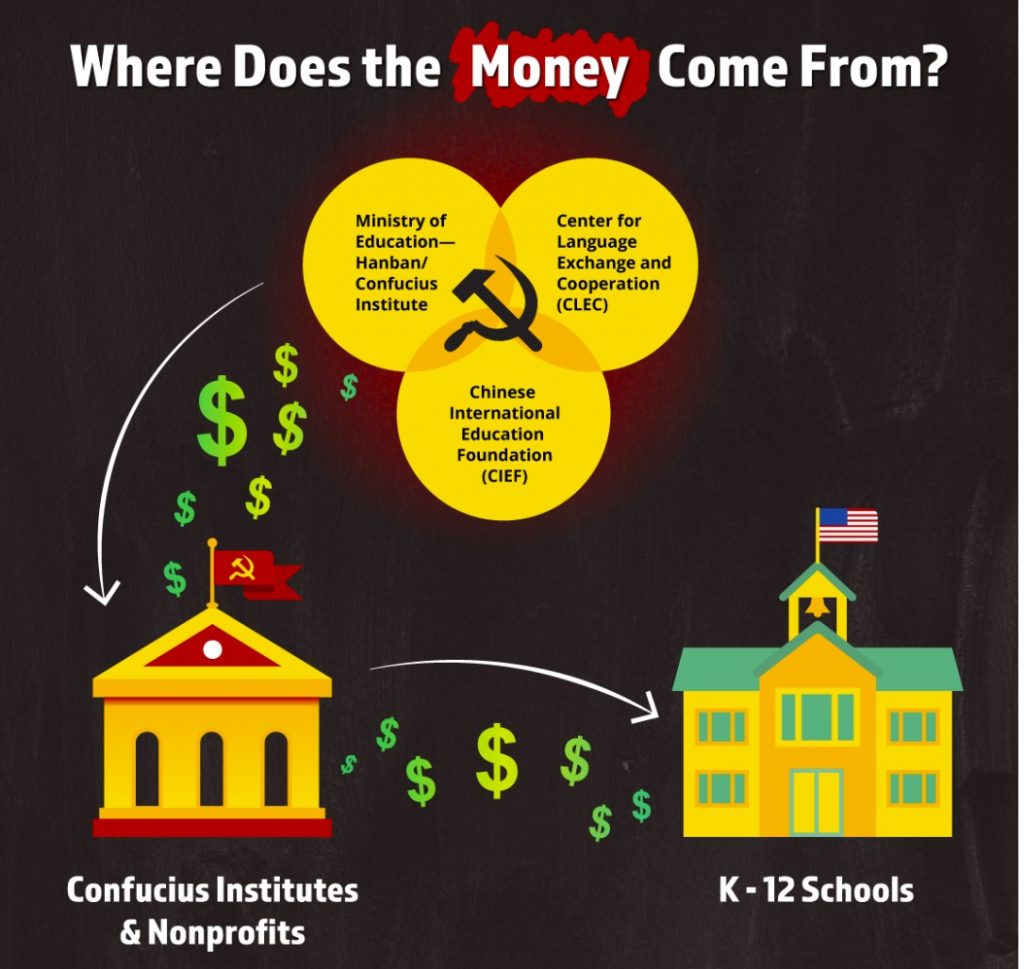
PART 2: CASE STUDIES
The extent of ties between Chinese-government affiliated institutions and American K-12 schools in Kentucky and North Carolina merit further detail. With three bases in Kentucky and eleven in North Carolina, the extent of these relationships are of particular concern.
KENTUCKY
In March 2010, the Western Kentucky University announced it would launch a Confucius Institute. The university appointed Dr. Wei-Ping Pan as its founding director. Dr. Pan is a leading expert in coal technology and was a professor at the North China Electric Power University—a school in Beijing which, according to its website, “has actively implemented the Belt and Road Initiative” through “national diplomatic missions and national foreign aid training programs.”
Gatton Academy, a prestigious science and technology high school, opened its doors at the Western Kentucky University three years earlier, in 2007. Gatton Academy is the number one science, engineering, technology, and math (STEM) school in Kentucky and often ranks among the top high schools in the United States.
According to public websites and public records, Gatton Academy participated in Western Kentucky University’s Confucius Institute programming and received funding from Hanban. In the summer of 2014, for example, five students from the STEM school participated in the “Confucius Institute’s High School China Summer Bridge Program.” Students spent two weeks in China “visiting cultural sites and participating in language courses and learning traditional activities.”
According to Western Kentucky University, its Confucius Institute initially brought eleven Chinese teachers to local public elementary and high schools in Barren, Logan, and Warren counties. Over the course of a decade, the Confucius Institute at Western Kentucky University expanded into classrooms in several counties, including: Cloverport, Hardin, Jefferson, and Oldham.
Jefferson County Public Schools’ contract noted that WKU’s Confucius Institute would apply to “Headquarters”—the Chinese Ministry of Education—for necessary start-up funds (up to $10,000) and a set amount of annual funds (up to $10,000 per year).”
In May 2018, Western Kentucky University Confucius Institute Interim Director Terrill D. Martin started BG Education Management Solutions, a nonprofit organization “designed for the promotion of international programs.” Its “core program” is the recruitment of “foreign language teachers who work in local K-12 schools in the U.S./Abroad.” According to an April 2021 report, BG Education Management Solutions requested $1.255 million from the Chinese International Education Foundation—an organization founded by Hanban. Martin’s group received $948,462 from the Chinese International Education Foundation in 2020.
CI-Agreement-Jefferson-County-Public-Schools-KY-March-11-2015 (1)
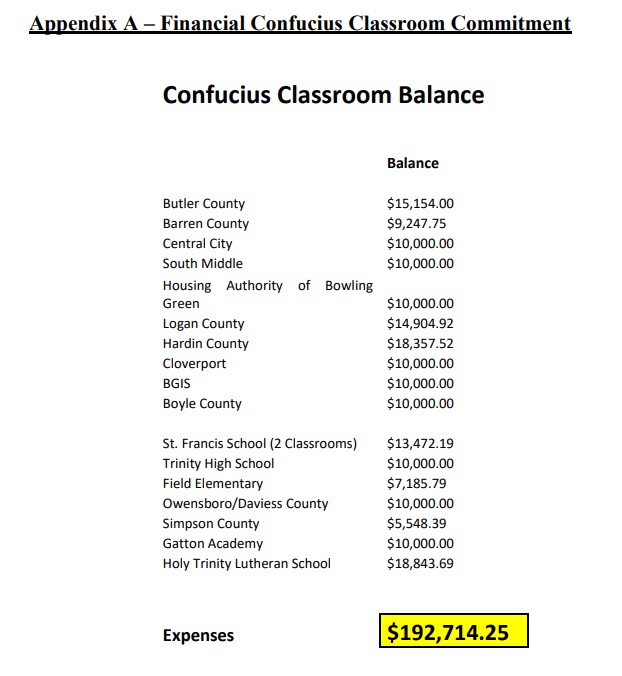
The University of Kentucky was also responsible for connecting K-12 public schools to Chinese government-backed programming through its Confucius Institute, founded in 2010. Fleming County Schools, Fayette County Schools, and Henderson County Schools all developed Chinese language or teacher exchange programming through the University of Kentucky.
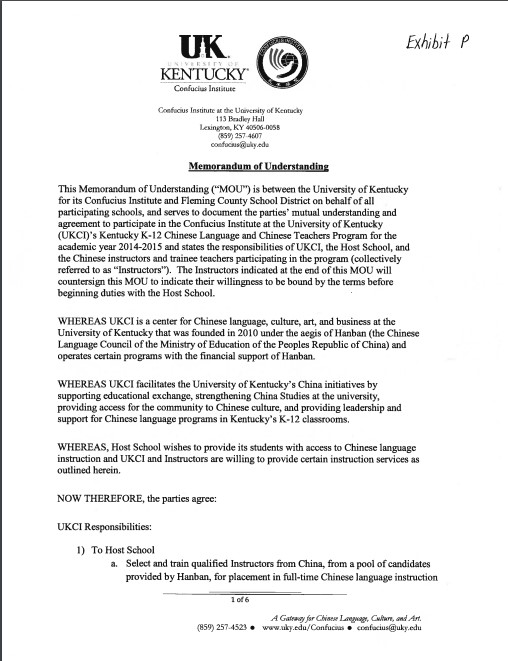
Chinese-government backed programming in Kentucky’s K-12 classrooms came from sources other than Confucius Institutes at nearby universities. For example, in 2011, Carroll County Schools signed a contract with the College Board’s “Chinese Guest Teacher Program.” According to the document, Hanban was to subsidize up to $13,000 of the guest teacher’s salary, which “should be commensurate with the salary amount paid to a U.S. teacher with similar responsibilities and similar education who is teaching full-time.”
The Kentucky Center for Mandarin Language and Culture, a program of the Northern Kentucky Cooperative for Educational Services, assists local school districts in hosting “highly qualified, licensed, native Chinese-speaking educators” with the intent to “provide Chinese language instruction at the elementary, middle, and high school level.” The Center has partnered with at least seven school districts in Kentucky to provide Chinese language programming. It is funded in part by the Beijing Language and Culture University, a key university directly under the Ministry of Education. The Beijing Language and Culture University is part of the Confucius Institute initiative.
NORTH CAROLINA
Go Global NC, founded in 1979 as the North Carolina Center for International Understanding, is a nonprofit government, business, and education leadership organization. It claims to have created “the nation’s first statewide network of Confucius Classrooms.” As such, Go Global NC has acted as an intermediary between Chinese government funds via Hanban and K-12 schools across North Carolina.
Go Global NC gave out grants ranging from $10,000 to $45,000 for Confucius Classrooms to six different North Carolina K-12 schools and districts—including Envision Science Academy, a top-rated science and technology charter school—according to its 2020 nonprofit fillings. Go Global NC touts its support for 34 Mandarin Language programs across the state, which have reached “approximately 8,490 students,” on its 2021 nonprofit filings.

Winston-Salem Forsyth schools received $10,000 in funding for each of three schools from Hanban through the North Carolina Center for International Understanding during the 2013-2014 school year. Unlike other programs, this funding “did not use the Chinese Guest Teachers” available through Hanban, nor did the district “work with Confucius Institutes.” One middle school eliminated their Chinese language program—and with it, their $10,000 cash stream from the Chinese government—in 2016-2017.
On January 28, 2015, The North Carolina School of Science and Mathematics (NCSSM)—the state’s top STEM high school, which often ranks among the top high schools nationwide—signed an agreement with the North Carolina Center for International Understanding to establish a Confucius Classroom. The North Carolina School of Science and Mathematics received grant funding from Hanban through the Center for International Understanding from 2015 to 2020.
In 2018, NCSSM was given the “Confucius Classroom of the Year” award from the Hanban. On its website, NCSSM stated that its Confucius programming included weekly video conferencing between American and Chinese students as well as “collaborative projects.”
The Wake County Public Schools Board of Education’s Proposed Budget for 2014-2015 notes that the district received $50,000 from Hanban through the North Carolina Center for International Understanding to operate Confucius Classrooms in five schools. A 2016-2017 Office of Grants summary report shows that the district received $40,000 from Go Global NC for “Confucius Classroom Programs” and another $10,000 from the “[North Carolina State University] Confucius Institute” and “Hanban Confucius Institute Program.” The proposed budget document for 2021-2022 shows that the district was still running Confucius Classrooms, relying on carry over funds.
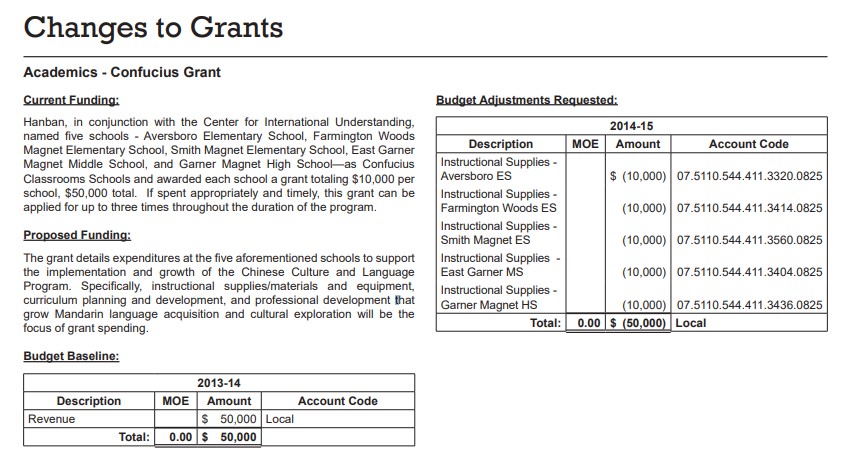
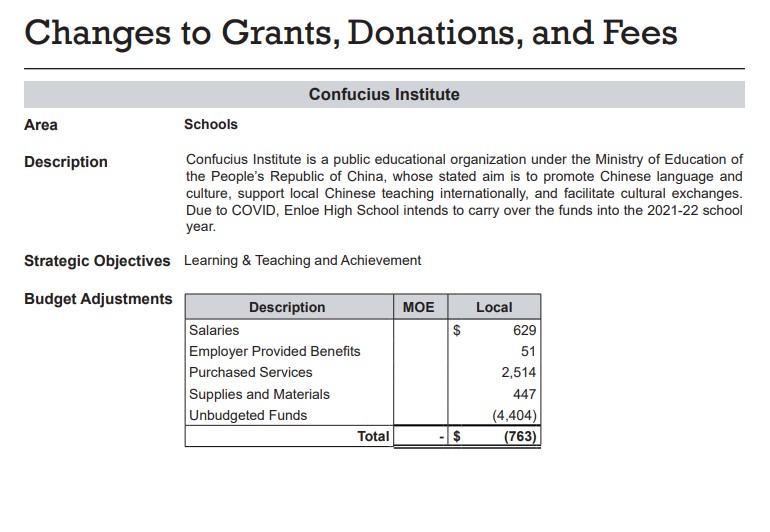
Similar to ties between Chinese government operations and K-12 schools in other states, at least one North Carolina school district’s Confucius Classroom received funding from the Confucius Institute at a state university. In 2020, Cabarrus County Schools received a $45,000 grant from Go Global NC for “Confucius Classroom allocation.” During the 2011-2012 school year, the district hosted a Chinese delegation which was part of an “educational agreement” between the North Carolina Board of Education and Jiangsu province. In 2015, the district also received a $10,000 grant for Confucius Classrooms through North Carolina State University. The money was intended to be used for “promoting the Chinese language and culture.”
PART 3: CONFUCIUS AROUND THE COUNTRY
CALIFORNIA
On September 14, 2016, San Diego Unified School District inked a contract with the Confucius Institute of San Diego State University. Documents show that the school district was to pay $10,000 to the Confucius Institute for Mandarin instructors who would “serve in a supportive role designed to enhance language and cultural experiences of students enrolled in district Mandarin language classes.”
MINNESOTA
St Cloud Area School District also participated in the Confucius Classroom programming through the Confucius Institute at St. Cloud State University and Minnesota State Colleges and Universities. Funding, which originated from Hanban through the Confucius Institute, included over $20,000 worth of equipment, books and curriculum materials, and over $65,0000 in grants.
As of June 2023, St. Cloud State University is one of two U.S. universities that receive Department of Defense funding for “to conduct sensitive military research” while hosting a Confucius Institute.
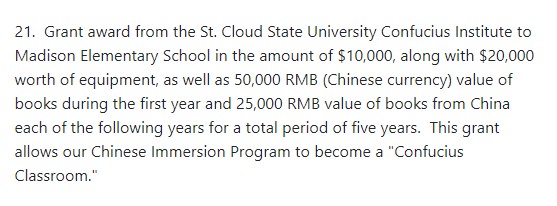
OHIO
The Gahanna-Jefferson School District Chinese program was started in 2008 with assistance from the Ohio Department of Education and The Ohio State University. According to the district website, in 2009 the district was selected as one of twenty “founding members of the Confucius Classroom Network” operated by the Asia Society and Hanban. Board documents reveal that the district received grants from the Asia Society and Hanban ranging from $8,524 to $12,900.
OKLAHOMA
On July 11, 2022, the Tulsa Public Schools board of education approved entering into an agreement with the Confucius Classroom Coordination Offices, which operates out of the International Leadership of Texas Global nonprofit. The Chinese International Education Foundation would cover the cost of the program. Carver middle school offers students a “Confucius Connection” through its “Global Awareness” programming. The site states that “Carver became a Confucius School through the Han Ban (sic) Confucius Institute.”
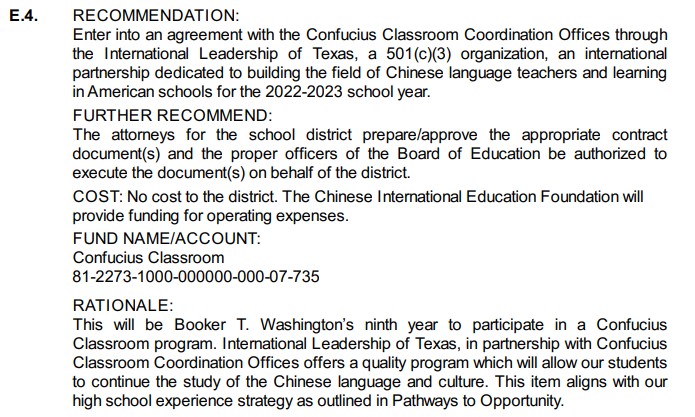
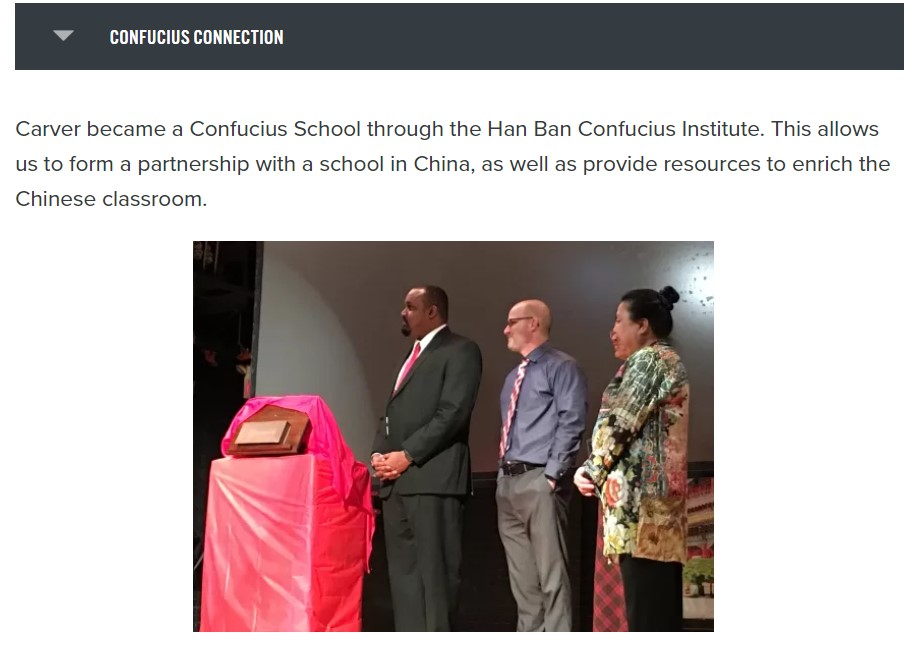
OREGON
The Sisters School District 2022-2023 Adopted Budget revealed that the Oregon district appears to still have a fiscal partnership with the Portland State University Confucius Institute. Line-item revenues revealed $15,513 in funding for the 2022-2023 school year. In 2015, an article featuring the district’s language program stated that the district was engaged in a partnership with the University’s Confucius Institute to offer students from elementary to high school the opportunity to study Mandarin Chinese. According to the article, the Sisters School District partnership was the “only program of its kind in Central Oregon and one of 25 across the state.”
The district’s high school World Languages page posts that its Chinese program featured “three native speaker Chinese teachers sponsored by Hanban, a part of the China Ministry of Education.” The district included on its “Our Partners” page a brief description of the Confucius Institute and Confucius Classroom. A Portland State University letter from January 27, 2021, stated that the university was “ending its agreement with the Confucius Institute.”
TEXAS
On September 7, 2022, the Highland Park Independent School District received $12,369.93 in grant funding from International Leadership of Texas Global for “the purpose of supporting Highland Park Middle School’s LOTE Department Chinese Course Curriculum.” In addition to the middle school grant, the district received $2,004.94 in funding from the International Leadership of Texas Global in support of the high school’s “Chinese course curriculum.”
In 2018, the high school received a $10,000 grant from the Confucius Institute at the University of Texas at Dallas. The “gift” was to be used “in support of Highland Park High School’s Confucius Classroom 2018 Annual Operation Funds.” In 2020, the Confucius Institute at the University of Texas at Dallas gave the district’s middle school a $20,000 grant for the “operation and supplies of the Chinese courses.” The funds were also to be used by a district staff member to “travel to China for educational purposes.” The high school also received a $20,000 “gift” to be used for the school’s “2019 and 2020 Confucius Classroom Annual Operating Funds.”
Read Texas Scorecard’s comprehensive report on Confucius Classroom programming across Texas.
VIRGINIA
Virginia Beach Public Schools signed a contract in 2015 to become part of the “Asia Society Confucius Classrooms Network.” The district’s Tallwood High School was awarded $13,000 in grants to operate the program, which included a partnership with a school in China, involvement in Asia Society activities, and attendance at national conferences. According to a June 30, 2015 report, the district joined the Asia Society network in 2009 and had offered Chinese as a language since 2005.
Tallwood High School signed another agreement with Asia Society on November 19, 2018 to continue as part of the Confucius Classroom Network. The grant award for $11,414 was to be used “to promote Chinese language and/or Chinese culture” and may also go towards “professional development/curriculum, cultural activities, field trips, operation/administration, and school-to-school partnerships.”
PART 4: RECOMMENDATIONS
State and federal officials should immediately begin investigations to determine the scope of China’s involvement, influence, and access to our K-12 student information and curriculum. This report should be made public once complete, so parents can make informed decisions on their children’s involvement in these controversial programs. Families should also have full access to view how these cultural and language immersion programs are financed.
At the Congressional level, committees of jurisdiction should move to hold hearings to determine the scope of this security vulnerability, and specifically to evaluate how China’s infiltration of our K-12 classrooms has compromised student information, curriculum data, and America’s intellectual property.
PDE will continue to stay focused on this concerning development. Please pass along all tips and information to: info@defendinged.org, so we can track down leads to be able to provide parents with an accurate perspective of how these programs are being manipulated to influence children across the United States.
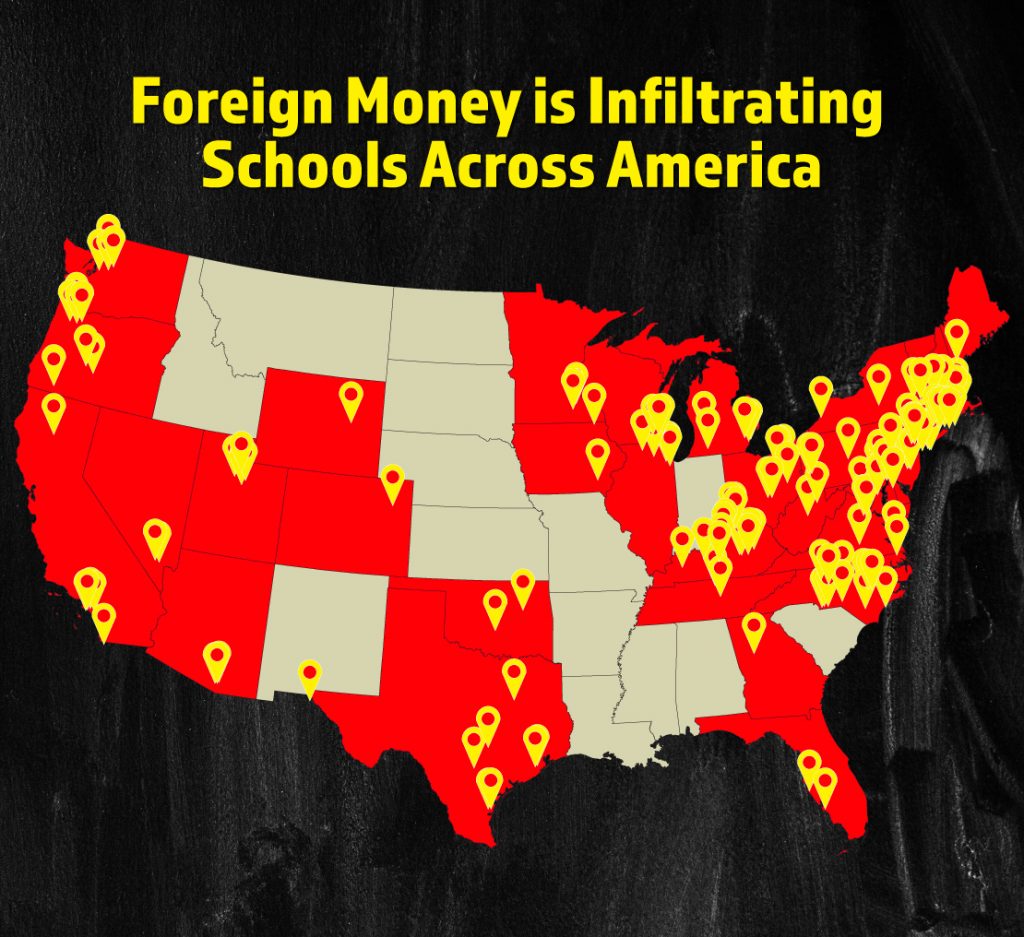
PART 5: STATES AND MILITARY BASES
Arizona
California
- Hacienda La Puente Unified School District
- Los Angeles Unified School District
- Manhattan Beach Unified School District
- Redding School of the Arts
- San Diego Unified School District
Colorado
Connecticut
- East Hartford Public Schools
- Glastonbury Public Schools
- Greenwich Public Schools
- Newtown Public Schools
- Norwalk Public Schools
- Simsbury Public Schools
- West Hartford Public Schools
Delaware
Florida
Georgia
Illinois
Iowa
Kentucky
- Beechwood Independent School District
- Carroll County Schools
- Cloverport Independent School District
- Fayette County Public Schools
- Fleming County Schools
- Francis Parker School of Louisville (St. Francis High School)
- Hardin County Public Schools
- Henderson County Schools
- Jefferson County Public Schools
- Louisville Collegiate School
- Montgomery County Schools
- Oldham County Schools
- Simpson County Schools
Maine
Maryland
Massachusetts
- Andover Public Schools
- Boston Renaissance Charter Public School
- Brooks School
- Lexington School District
- Medfield Public Schools
Michigan
- Forest Hills Public Schools
- Grosse Point Public School System
- Oxford Community Schools
- Portage Public Schools
- Roeper School
Minnesota
Nevada
New Hampshire
New Jersey
- Bergenfield Public School District
- Englewood Public School District
- Glen Ridge Public Schools
- Lawrence Township Public Schools
- Peddie School
- Piscataway Township School District
- Princeton Public Schools
- The Pingry School
- Wardlaw-Hartridge School
- West Orange Public Schools
New York
- Dalton School
- Half Hallow Hills Central School District
- Herricks Public Schools
- Jericho Public Schools
- Massapequa School District
- New York City Department of Education
- Nichols School
- Oneida-Herkimer-Madison BOCES
- Plainview-Old Bethpage Central School District
- Ramapo Central School District
- Suffern Central School District
- Washington-Saratoga-Warren-Hamilton-Essex BOCES
North Carolina
- Carrabus County Schools
- Charlotte-Mecklenburg Schools
- Cumberland County Schools
- Envision Science Academy
- Guilford County Schools
- Mount Airy City Schools
- North Carolina School of Science and Mathematics
- Randolph County Schools
- Union County Public Schools
- Wake County Public Schools
- Winston-Salem/ Forsyth County Schools
Ohio
- Brooklyn City School District
- Chagrin Falls Schools
- Columbus School for Girls
- Gahanna-Jefferson School District
- Shaker Heights Schools
- Winton Woods City School District
Oklahoma
Oregon
- Beaverton School District
- Bend – La Pine Schools
- Hillsboro School District
- St. Mary’s School
- Sisters School District
- West Linn-Wilsonville School District
Pennsylvania
- Germantown Academy
- School District of Philadelphia
- Sewickley Academy
- Southern Lehigh School District
- State College Area School District
- The Hill School
Rhode Island
Tennessee
Texas
- Austin Independent School District
- Coppell Independent School District
- Episcopal School of Dallas
- Highland Park Independent School District
- Houston Independent School District
- Mathis Independent School District
- North East Independent School District
- YES Prep Public Schools – Brays-Oaks
- Yselta Independent School District
Utah
- Davis School District
- Granite School District
- Provo City School District
- Renaissance Academy
- Salt Lake City School District
Vermont
Virginia
- Collegiate School
- Fairfax County Public Schools
- Falls Church City Public Schools
- Norfolk Public Schools
- Virginia Beach City Public Schools
Washington
- Bellevue School District
- Issaquah School District 411
- Peninsula School District
- Seattle Public Schools
Washington D.C.
West Virginia
Wisconsin
- Kettle Moraine School District
- Oconomowoc Area School District
- School District of Janesville
- University School of Milwaukee
Wyoming
Military Bases Nearby These School Districts:
- U.S. Naval Academy and Naval Support Activity (NSA) Annapolis
- Buckley Air Force Base and Space Force
- Davis-Monthan Air Force Base
- Dover Air Force Base
- Fort Bliss
- Fort Liberty (formerly known as Fort Bragg)
- Fort Knox
- Naval Station Great Lakes
- Hanscom Air Force Base
- Hill Air Force Base
- Lackland Air Force Base
- Langley Air Force Base
- Los Angeles Air Force Base
- MacDill Air Force Base
- McGuire Air Force Base
- U.S. Coast Guard Academy and Naval Submarine Base New London
- Nellis Air Force Base
- Naval Station Norfolk
- Puget Sound Naval Shipyard
- Naval Base San Diego
References
1 “Fairfax County Public Schools’ top STEM Academy Fund received over a million dollars in funding from Chinese organizations, documents show,” Defendinged.org, (3/7/23), Accessed July 11, 2023, https://defendinged.org/investigations/fairfax-county-public-schools-top-stem-academy-fund-received-over-a-million-dollars-in-funding-from-chinese-organizations-documents-show/
2 Interestingly, Portland State University in 2021 wrote a disengagement letter, noting that it would end its Confucius Institute ties. A Sisters School District Budget from 2022-2023 notes that it works with Portland State University’s Confucius Institute to provide Mandarin programming.
3 Portman, Rob and Tom Carper, “China’s Impact on the U.S. Education System,” Permanent Subcommittee on Investigations, Committee on Homeland Security and Governmental Affairs, Accessed July 11, 2023, https://www.hsgac.senate.gov/wp-content/uploads/imo/media/doc/PSI%20Report%20China’s%20Impact%20on%20the%20US%20Education%20System.pdf
5 https://www.politico.com/magazine/story/2018/01/16/how-china-infiltrated-us-classrooms-216327/
6 “Confucius Institute Annual Development Report 2017,” Hanban, Accessed July 11, 2023, https://web.archive.org/web/20190620174721/http:/www.hanban.org/report/2017.pdf
7 https://www.brookings.edu/articles/its-time-for-a-new-policy-on-confucius-institutes/
8 “Corrupting the College Board: Confucius Institutes and K-12 Education,” National Association of Scholars, Accessed July 11, 2023, https://files.eric.ed.gov/fulltext/ED609566.pdf
9 2014 National Chinese Language Conference,” Asia Society, Accessed July 11, 2023, https://asiasociety.org/sites/default/files/N/NCLC14%20Program%20Book.pdf
12 https://www.aspi.org.au/report/china-defence-universities-tracker
14 “Sisters School District #6 Adopted Budget 2022-2023,” Accessed July 11, 2023, http://ssd6.org/files/2022/06/0.0-22-23-ADOPTED-BUDGET.pdf
15 “International Leadership of Texas Global,” (7/11/23), https://www.iltexasglobal.org
16 Every day we work to build connections,” Go Global NC, https://globalnc.orgin
17 Go Global NC Council Inc. Full text of “Form 990, Schedule I” for Fiscal Year ending June 2021,” Accessed July 11, 2023, https://projects.propublica.org/nonprofits/organizations/561751280/202231339349305433/IRS990ScheduleI
18 “NCSSM wins Confucius Classroom of the Year Award,” (1/17/18), Accessed July 11, 2023, North Carolina School for Science and Technology, https://www.ncssm.edu/stories/2018/01/17/ncssm-wins-confucius-classroom-of-the-year-award
19 http://www.wku.edu/academy/news/index.php?view=article&articleid=3300&return=archive
20 https:www.wku.edu/academy/news/index.php?view=article&articleid=4138
